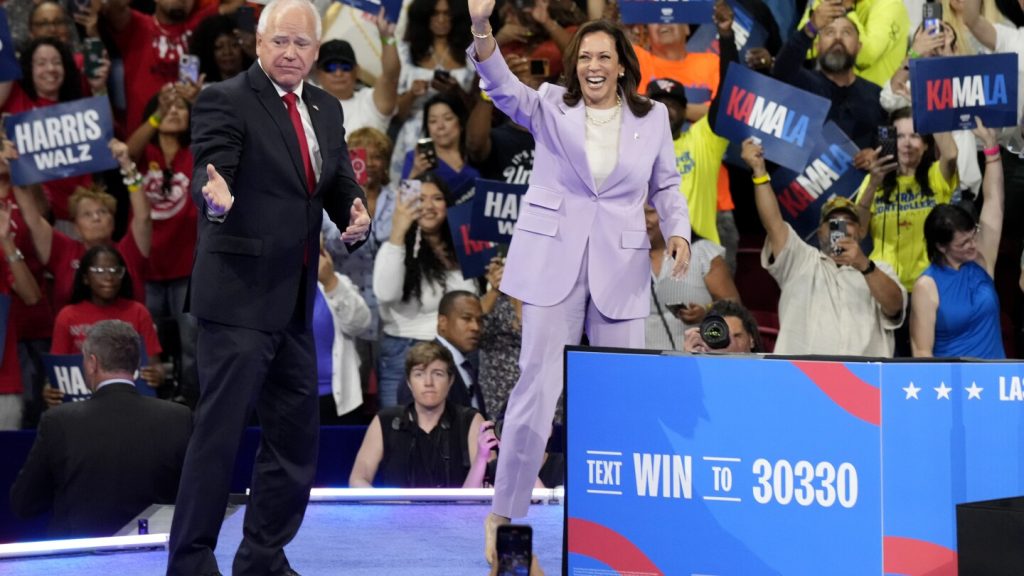The Democratic Party is targeting seven critical battleground states with paid advertising for Vice President Kamala Harris and Minnesota Gov. Tim Walz. The DNC announced the Harris-Walz advertising push, which includes more than 70 billboards across key battleground states like Arizona, Georgia, Michigan, North Carolina, Nevada, Pennsylvania, and Wisconsin. This advertising blitz is set to determine the outcome of the presidential election in November and will be strategically placed in urban areas along major interstates and highways, including in Atlanta, Detroit, Charlotte, and Philadelphia. Additionally, there is an advertisement in the Las Vegas strip in both English and Spanish to reach a diverse audience. The message of the campaign is that Harris and Walz are fighting for working people, while the opposition is only out for themselves.
The Harris-Walz campaign has amassed a significant amount of funds, with $310 million raised in July and $377 million on hand as they entered August. This fundraising puts them in a strong financial position compared to the Trump campaign, which raised just over $138 million last month with $327 million to spend. The advertising push follows a successful battleground state tour by Harris and Walz, with enthusiastic crowds in Pennsylvania, Wisconsin, and Arizona. A planned stop in North Carolina was postponed due to inclement weather from Tropical Storm Debby. Donald Trump’s running mate JD Vance shadowed the Democratic pair throughout the week, holding news conferences in the same cities they visited, while Trump himself held a rally in Montana. The Trump campaign also launched their own advertisements focusing on Harris’ record on immigration and calling her a “border czar.”
The Democratic National Committee is making a strategic move to saturate key battleground states with advertising for Vice President Kamala Harris and Minnesota Gov. Tim Walz as they gear up for the presidential election in November. This push includes billboards in urban areas and along major highways in states like Arizona, Georgia, Michigan, North Carolina, Nevada, Pennsylvania, and Wisconsin. The campaign emphasizes that Harris and Walz are fighting for working people, while their opponents are only looking out for themselves. The DNC’s message will be delivered through a mix of English and Spanish advertisements to ensure a wide reach among the diverse populations in these crucial states.
With a substantial amount of fundraising behind them, the Harris-Walz campaign is in a strong financial position, having raised $310 million in July and maintaining $377 million on hand as they head into August. This financial advantage over the Trump campaign, which raised $138 million in the same period, gives the Democrats a significant edge in terms of advertising and campaigning. After completing a successful tour of battleground states, Harris and Walz are gaining momentum with enthusiastic crowds and support from various regions across the country. Despite some weather-related setbacks, their campaign continues to push forward with a focus on engaging key states and mobilizing voters.
The competition between the Harris-Walz ticket and the Trump campaign is heating up as both sides ramp up their advertising efforts and campaign presence. While Harris and Walz have been touring battleground states and energizing crowds, Trump’s running mate JD Vance has been shadowing them and holding press conferences in the same cities. Trump himself has hosted rallies and launched a series of advertisements criticizing Harris’ record on immigration. This back-and-forth dynamic sets the stage for a highly contested election as both campaigns seek to sway undecided voters and solidify support in critical states. The outcome of the November election could be determined by the effectiveness of these advertising strategies and campaign efforts in key battleground regions.
The battle for the presidency is intensifying as the Democratic Party focuses on key battleground states with paid advertising for Vice President Kamala Harris and Minnesota Gov. Tim Walz. The DNC’s strategic approach includes billboards strategically placed in urban areas and along major interstates and highways in states like Arizona, Georgia, Michigan, North Carolina, Nevada, Pennsylvania, and Wisconsin. With a strong financial backing from successful fundraising efforts, the Harris-Walz campaign is in a favorable position compared to the Trump campaign, which has also been active in launching advertisements and holding rallies. The upcoming election in November will be crucial, and both parties are making significant efforts to win over voters and secure victory in this highly contested race.


